Global Land Monsoon Area Response to Natural Forcing Drivers over the Last Millennium in a Community Earth System Model Ensemble
Abstract
1. Introduction
2. Materials and Methods
2.1. Model Data
2.2. Definition of Global Land Monsoon Area
2.3. Identification of Driver Episodes
- Cool-GMST-only episodes (215 episodes): Identified when the GMST anomaly is below −1.5 standard deviations and the corresponding TPTG anomaly remains within ±1.0 standard deviations.
- Weak-TPTG-only episodes (18 episodes): Identified when the TPTG anomaly is below −1.5 standard deviations and the corresponding GMST anomaly remains within ±1.0 standard deviations.
- Compound episodes (36 episodes): Identified when both the GMST anomaly is below −1.5 standard deviations and the TPTG anomaly is below −1.5 standard deviations.
3. Results
3.1. Forced Variability of GLM Area and Contributions from GMST and TPTG
3.2. Composite GLM Area Response to Driver Episodes
3.3. Spatial Patterns of GLM Area Change
4. Discussion
4.1. Validation of the Forced GLM Area Response
4.2. Differential Sensitivity of GLM Area Versus Intensity
4.3. Mechanisms of GLM Area Change: Roles of APR and SPF Criteria
4.3.1. GLM Area Response Mechanisms Under Cool-GMST-Only Conditions
4.3.2. GLM Area Response Mechanisms Under Weak-TPTG-Only Conditions
4.4. Synergistic Effects and Amplified GLM Area Response Under Compound Conditions
5. Conclusions
Supplementary Materials
Author Contributions
Funding
Data Availability Statement
Acknowledgments
Conflicts of Interest
References
- Trenberth, K.E.; Branstator, G.W.; Karoly, D.; Kumar, A.; Lau, N.; Ropelewski, C. Progress During TOGA in Understanding and Modeling Global Teleconnections Associated with Tropical Sea Surface Temperatures. J. Geophys. Res. Oceans 1998, 103, 14291–14324. [Google Scholar] [CrossRef]
- Webster, P.J.; Magaña, V.O.; Palmer, T.N.; Shukla, J.; Tomas, R.A.; Yanai, M.; Yasunari, T. Monsoons: Processes, Predictability, and the Prospects for Prediction. J. Geophys. Res. Oceans 1998, 103, 14451–14510. [Google Scholar] [CrossRef]
- Zhou, T.; Zhang, L.; Li, H. Changes in Global Land Monsoon Area and Total Rainfall Accumulation over the Last Half Century. Geophys. Res. Lett. 2008, 35, L16707. [Google Scholar] [CrossRef]
- Vecchi, G.A.; Soden, B.J.; Wittenberg, A.T.; Held, I.M.; Leetmaa, A.; Harrison, M.J. Weakening of Tropical Pacific Atmospheric Circulation Due to Anthropogenic Forcing. Nature 2006, 441, 73–76. [Google Scholar] [CrossRef]
- Collins, M.; An, S.-I.; Cai, W.; Ganachaud, A.; Guilyardi, E.; Jin, F.-F.; Jochum, M.; Lengaigne, M.; Power, S.; Timmermann, A.; et al. The Impact of Global Warming on the Tropical Pacific Ocean and El Niño. Nat. Geosci. 2010, 3, 391–397. [Google Scholar] [CrossRef]
- Power, S.; Delage, F.; Chung, C.; Kociuba, G.; Keay, K. Robust Twenty-First-Century Projections of El Niño and Related Precipitation Variability. Nature 2013, 502, 541–545. [Google Scholar] [CrossRef]
- Wang, B.; Liu, J.; Kim, H.-J.; Webster, P.J.; Yim, S.-Y. Recent Change of the Global Monsoon Precipitation (1979–2008). Clim. Dyn. 2012, 39, 1123–1135. [Google Scholar] [CrossRef]
- Wang, B.; Ding, Q. Changes in Global Monsoon Precipitation over the Past 56 Years. Geophys. Res. Lett. 2006, 33, L06711. [Google Scholar] [CrossRef]
- Wang, B.; Ding, Q. Global Monsoon: Dominant Mode of Annual Variation in the Tropics. Dyn. Atmos. Oceans 2008, 44, 165–183. [Google Scholar] [CrossRef]
- Kitoh, A.; Endo, H.; Krishna Kumar, K.; Cavalcanti, I.F.A.; Goswami, P.; Zhou, T. Monsoons in a Changing World: A Regional Perspective in a Global Context. J. Geophys. Res. Atmos. 2013, 118, 3053–3065. [Google Scholar] [CrossRef]
- Held, I.M.; Soden, B.J. Robust Responses of the Hydrological Cycle to Global Warming. J. Clim. 2006, 19, 5686–5699. [Google Scholar] [CrossRef]
- Hsu, P.; Li, T.; Luo, J.; Murakami, H.; Kitoh, A.; Zhao, M. Increase of Global Monsoon Area and Precipitation under Global Warming: A Robust Signal? Geophys. Res. Lett. 2012, 39, L06701. [Google Scholar] [CrossRef]
- Lee, J.-Y.; Wang, B. Future Change of Global Monsoon in the CMIP5. Clim. Dyn. 2014, 42, 101–119. [Google Scholar] [CrossRef]
- Wang, B.; Xiang, B.; Lee, J.-Y. Subtropical High Predictability Establishes a Promising Way for Monsoon and Tropical Storm Predictions. Proc. Natl. Acad. Sci. USA 2013, 110, 2718–2722. [Google Scholar] [CrossRef] [PubMed]
- Zuo, M.; Man, W.; Zhou, T. Dependence of Global Monsoon Response to Volcanic Eruptions on the Background Oceanic States. J. Clim. 2021, 34, 8273–8289. [Google Scholar] [CrossRef]
- Ropelewski, C.F.; Halpert, M.S. Global and Regional Scale Precipitation Patterns Associated with the El Niño/Southern Oscillation. Mon. Wea. Rev. 1987, 115, 1606–1626. [Google Scholar] [CrossRef]
- Kumar, K.K.; Rajagopalan, B.; Cane, M.A. On the Weakening Relationship Between the Indian Monsoon and ENSO. Science 1999, 284, 2156–2159. [Google Scholar] [CrossRef]
- Wang, B.; Wu, R.; Fu, X. Pacific–East Asian Teleconnection: How Does ENSO Affect East Asian Climate? J. Clim. 2000, 13, 1517–1536. [Google Scholar] [CrossRef]
- Asutosh, A.; Vinoj, V.; Landu, K.; Wang, H. Fast Response of Global Monsoon Area and Precipitation to Regional Carbonaceous Aerosols. Atmos. Res. 2024, 304, 107354. [Google Scholar] [CrossRef]
- Marvel, K.; Schmidt, G.A.; Miller, R.L.; Nazarenko, L.S. Implications for Climate Sensitivity from the Response to Individual Forcings. Nat. Clim. Chang. 2016, 6, 386–389. [Google Scholar] [CrossRef]
- Wu, T.; Hu, A.; Gao, F.; Zhang, J.; Meehl, G.A. New Insights into Natural Variability and Anthropogenic Forcing of Global/Regional Climate Evolution. npj Clim. Atmos. Sci. 2019, 2, 18. [Google Scholar] [CrossRef]
- Polson, D.; Bollasina, M.; Hegerl, G.C.; Wilcox, L.J. Decreased Monsoon Precipitation in the Northern Hemisphere Due to Anthropogenic Aerosols. Geophys. Res. Lett. 2014, 41, 6023–6029. [Google Scholar] [CrossRef]
- Miller, G.H.; Geirsdóttir, Á.; Zhong, Y.; Larsen, D.J.; Otto-Bliesner, B.L.; Holland, M.M.; Bailey, D.A.; Refsnider, K.A.; Lehman, S.J.; Southon, J.R.; et al. Abrupt Onset of the Little Ice Age Triggered by Volcanism and Sustained by Sea-ice/Ocean Feedbacks. Geophys. Res. Lett. 2012, 39, L02708. [Google Scholar] [CrossRef]
- Robock, A. Volcanic Eruptions and Climate. Rev. Geophys. 2000, 38, 191–219. [Google Scholar] [CrossRef]
- Crowley, T.J. Causes of Climate Change Over the Past 1000 Years. Science 2000, 289, 270–277. [Google Scholar] [CrossRef]
- Jungclaus, J.H.; Bard, E.; Baroni, M.; Braconnot, P.; Cao, J.; Chini, L.P.; Egorova, T.; Evans, M.; González-Rouco, J.F.; Goosse, H.; et al. The PMIP4 Contribution to CMIP6—Part 3: The Last Millennium, Scientific Objective, and Experimental Design for the PMIP4 Past1000 Simulations. Geosci. Model Dev. 2017, 10, 4005–4033. [Google Scholar] [CrossRef]
- Clement, A.C.; Seager, R.; Cane, M.A.; Zebiak, S.E. An Ocean Dynamical Thermostat. J. Clim. 1996, 9, 2190–2196. [Google Scholar] [CrossRef]
- Brad Adams, J.; Mann, M.E.; Ammann, C.M. Proxy Evidence for an El Niño-like Response to Volcanic Forcing. Nature 2003, 426, 274–278. [Google Scholar] [CrossRef] [PubMed]
- Emile-Geay, J.; Seager, R.; Cane, M.A.; Cook, E.R.; Haug, G.H. Volcanoes and ENSO over the Past Millennium. J. Clim. 2008, 21, 3134–3148. [Google Scholar] [CrossRef]
- McGregor, S.; Timmermann, A. The Effect of Explosive Tropical Volcanism on ENSO. J. Clim. 2011, 24, 2178–2191. [Google Scholar] [CrossRef]
- Zuo, M.; Man, W.; Zhou, T.; Guo, Z. Different Impacts of Northern, Tropical, and Southern Volcanic Eruptions on the Tropical Pacific SST in the Last Millennium. J. Clim. 2018, 31, 6729–6744. [Google Scholar] [CrossRef]
- Zuo, M.; Zhou, T.; Man, W. Hydroclimate Responses over Global Monsoon Regions Following Volcanic Eruptions at Different Latitudes. J. Clim. 2019, 32, 4367–4385. [Google Scholar] [CrossRef]
- Zuo, M.; Zhou, T.; Man, W.; Chen, X.; Liu, J.; Liu, F.; Gao, C. Volcanoes and Climate: Sizing up the Impact of the Recent Hunga Tonga-Hunga Ha’apai Volcanic Eruption from a Historical Perspective. Adv. Atmos. Sci. 2022, 39, 1986–1993. [Google Scholar] [CrossRef]
- Man, W.; Zuo, M.; Zhou, T.; Fasullo, J.T.; Bethke, I.; Chen, X.; Zou, L.; Wu, B. Potential Influences of Volcanic Eruptions on Future Global Land Monsoon Precipitation Changes. Earth’s Future 2021, 9, e2020EF001803. [Google Scholar] [CrossRef]
- Sun, W.; Wang, B.; Chen, D.; Gao, C.; Lu, G.; Liu, J. Global Monsoon Response to Tropical and Arctic Stratospheric Aerosol Injection. Clim. Dyn. 2020, 55, 2107–2121. [Google Scholar] [CrossRef]
- Zhou, T.; Wu, B.; Dong, L.; Zhou, T.; Wu, B.; Dong, L. Advances in Research of ENSO Changes and the Associated Impacts on Asian-Pacific Climate. Asia-Pac. J. Atmos. Sci. 2014, 50, 405–422. [Google Scholar] [CrossRef]
- Liu, F.; Chai, J.; Wang, B.; Liu, J.; Zhang, X.; Wang, Z. Global Monsoon Precipitation Responses to Large Volcanic Eruptions. Sci. Rep. 2016, 6, 24331. [Google Scholar] [CrossRef] [PubMed]
- Wang, Z.; Li, L.Z.X.; Shi, X.; Wang, J.; Jia, J. Influence of Natural External Forcings on Interdecadal Variation of Global Land Monsoon over the Last Millennium in CESM-LME. J. Clim. 2024, 37, 4807–4820. [Google Scholar] [CrossRef]
- Wang, Z.; Li, L.Z.X.; Hu, F.; Wang, J.; Jia, J. Decadal Responses of Global Land Monsoon to Two Surface Thermal Modes in the Last Millennium. J. Clim. 2025. Under Review. [Google Scholar]
- Otto-Bliesner, B.L.; Brady, E.C.; Fasullo, J.; Jahn, A.; Landrum, L.; Stevenson, S.; Rosenbloom, N.; Mai, A.; Strand, G. Climate Variability and Change since 850 CE: An Ensemble Approach with the Community Earth System Model. Bull. Am. Meteorol. Soc. 2016, 97, 735–754. [Google Scholar] [CrossRef]
- Stevenson, S.; Otto-Bliesner, B.; Fasullo, J.; Brady, E. “El Niño Like” Hydroclimate Responses to Last Millennium Volcanic Eruptions. J. Clim. 2016, 29, 2907–2921. [Google Scholar] [CrossRef]
- Liu, J.; Wang, B.; Yim, S.-Y.; Lee, J.-Y.; Jhun, J.-G.; Ha, K.-J. What Drives the Global Summer Monsoon over the Past Millennium? Clim. Dyn. 2012, 39, 1063–1072. [Google Scholar] [CrossRef]
- Zinke, J.; Browning, S.A.; Hoell, A.; Goodwin, I.D. The West Pacific Gradient Tracks ENSO and Zonal Pacific Sea Surface Temperature Gradient During the Last Millennium. Sci. Rep. 2021, 11, 20395. [Google Scholar] [CrossRef] [PubMed]
- Gao, C.; Robock, A.; Ammann, C. Volcanic Forcing of Climate over the Past 1500 Years: An Improved Ice Core-Based Index for Climate Models. J. Geophys. Res. Atmos. 2008, 113, D23111. [Google Scholar] [CrossRef]
- Lean, J.L. Cycles and Trends in Solar Irradiance and Climate. WIREs Clim. Chang. 2010, 1, 111–122. [Google Scholar] [CrossRef]
- Wang, J.; Lu, H.; Cheng, J.; Zhao, C. Global Terrestrial Monsoon Area Variations since Last Glacial Maximum Based on TraCE21ka and PMIP4-CMIP6 Simulations. Glob. Planet. Chang. 2023, 231, 104308. [Google Scholar] [CrossRef]
- Jiang, D.; Tian, Z.; Lang, X.; Kageyama, M.; Ramstein, G. The Concept of Global Monsoon Applied to the Last Glacial Maximum: A Multi-Model Analysis. Quat. Sci. Rev. 2015, 126, 126–139. [Google Scholar] [CrossRef]
- Jiang, D.; Tian, Z.; Lang, X. Mid-Holocene Global Monsoon Area and Precipitation from PMIP Simulations. Clim. Dyn. 2015, 44, 2493–2512. [Google Scholar] [CrossRef]
- Yan, M.; Wang, B.; Liu, J. Global Monsoon Change During the Last Glacial Maximum: A Multi-Model Study. Clim. Dyn. 2016, 47, 359–374. [Google Scholar] [CrossRef]
- Chen, J.; Chen, F.; Feng, S.; Huang, W.; Liu, J.; Zhou, A. Hydroclimatic Changes in China and Surroundings During the Medieval Climate Anomaly and Little Ice Age: Spatial Patterns and Possible Mechanisms. Quat. Sci. Rev. 2015, 107, 98–111. [Google Scholar] [CrossRef]
- Chen, J.; Liu, J.; Zhang, X.; Chen, S.; Huang, W.; Chen, J.; Zhang, S.; Zhou, A.; Chen, F. Unstable Little Ice Age Climate Revealed by High-Resolution Proxy Records from Northwestern China. Clim. Dyn. 2019, 53, 1517–1526. [Google Scholar] [CrossRef]
- Liu, J.; Chen, J.; Zhang, X.; Li, Y.; Rao, Z.; Chen, F. Holocene East Asian Summer Monsoon Records in Northern China and Their Inconsistency with Chinese Stalagmite δ18O Records. Earth-Sci. Rev. 2015, 148, 194–208. [Google Scholar] [CrossRef]
- Liu, J.; Chen, S.; Chen, J.; Zhang, Z.; Chen, F. Chinese Cave δ18O Records Do Not Represent Northern East Asian Summer Monsoon Rainfall. Proc. Natl. Acad. Sci. USA 2017, 114, E2987–E2988. [Google Scholar] [CrossRef]
- Wang, H.; Xie, S.-P.; Kosaka, Y.; Liu, Q.; Du, Y. Dynamics of Asian Summer Monsoon Response to Anthropogenic Aerosol Forcing. J. Clim. 2019, 32, 843–858. [Google Scholar] [CrossRef]
- Chen, F.; Chen, J.; Huang, W.; Chen, S.; Huang, X.; Jin, L.; Jia, J.; Zhang, X.; An, C.; Zhang, J.; et al. Westerlies Asia and Monsoonal Asia: Spatiotemporal Differences in Climate Change and Possible Mechanisms on Decadal to Sub-Orbital Timescales. Earth-Sci. Rev. 2019, 192, 337–354. [Google Scholar] [CrossRef]
- Webster, P.J.; Yang, S. Monsoon and Enso: Selectively Interactive Systems. Q. J. R. Meteorol. Soc. 1992, 118, 877–926. [Google Scholar] [CrossRef]
- Liu, Y.; Lo, L.; Shi, Z.; Wei, K.-Y.; Chou, C.-J.; Chen, Y.-C.; Chuang, C.-K.; Wu, C.-C.; Mii, H.-S.; Peng, Z.; et al. Obliquity Pacing of the Western Pacific Intertropical Convergence Zone over the Past 282,000 Years. Nat. Commun. 2015, 6, 10018. [Google Scholar] [CrossRef]
- Chen, Z.; Zhou, T.; Chen, X.; Zhang, W.; Zhang, L.; Wu, M.; Zou, L. Observationally Constrained Projection of Afro-Asian Monsoon Precipitation. Nat. Commun. 2022, 13, 2552. [Google Scholar] [CrossRef]
- Nicholson, S.E. Climate and Climatic Variability of Rainfall over Eastern Africa. Rev. Geophys. 2017, 55, 590–635. [Google Scholar] [CrossRef]
- Palmer, P.I.; Wainwright, C.M.; Dong, B.; Maidment, R.I.; Wheeler, K.G.; Gedney, N.; Hickman, J.E.; Madani, N.; Folwell, S.S.; Abdo, G.; et al. Drivers and Impacts of Eastern African Rainfall Variability. Nat. Rev. Earth Environ. 2023, 4, 254–270. [Google Scholar] [CrossRef]
- Chevalier, M.; Brewer, S.; Chase, B.M. Qualitative Assessment of PMIP3 Rainfall Simulations across the Eastern African Monsoon Domains During the Mid-Holocene and the Last Glacial Maximum. Quat. Sci. Rev. 2017, 156, 107–120. [Google Scholar] [CrossRef]
- Khodri, M.; Izumo, T.; Vialard, J.; Janicot, S.; Cassou, C.; Lengaigne, M.; Mignot, J.; Gastineau, G.; Guilyardi, E.; Lebas, N.; et al. Tropical Explosive Volcanic Eruptions Can Trigger El Niño by Cooling Tropical Africa. Nat. Commun. 2017, 8, 778. [Google Scholar] [CrossRef]
- Pausata, F.S.R.; Zhao, Y.; Zanchettin, D.; Caballero, R.; Battisti, D.S. Revisiting the Mechanisms of ENSO Response to Tropical Volcanic Eruptions. Geophys. Res. Lett. 2023, 50, e2022GL102183. [Google Scholar] [CrossRef]
- Zuo, M.; Zhou, T.; Man, W. Response of Summer Precipitation over the Tibetan Plateau to Large Tropical Volcanic Eruptions in the Last Millennium. Clim. Dyn. 2023, 60, 3121–3138. [Google Scholar] [CrossRef]
- Moon, S.; Ha, K.-J.; Lee, S.-S. Impact of Anthropogenic Warming on Emergence of Extreme Precipitation over Global Land Monsoon Area. Environ. Res. Lett. 2024, 19, 034018. [Google Scholar] [CrossRef]
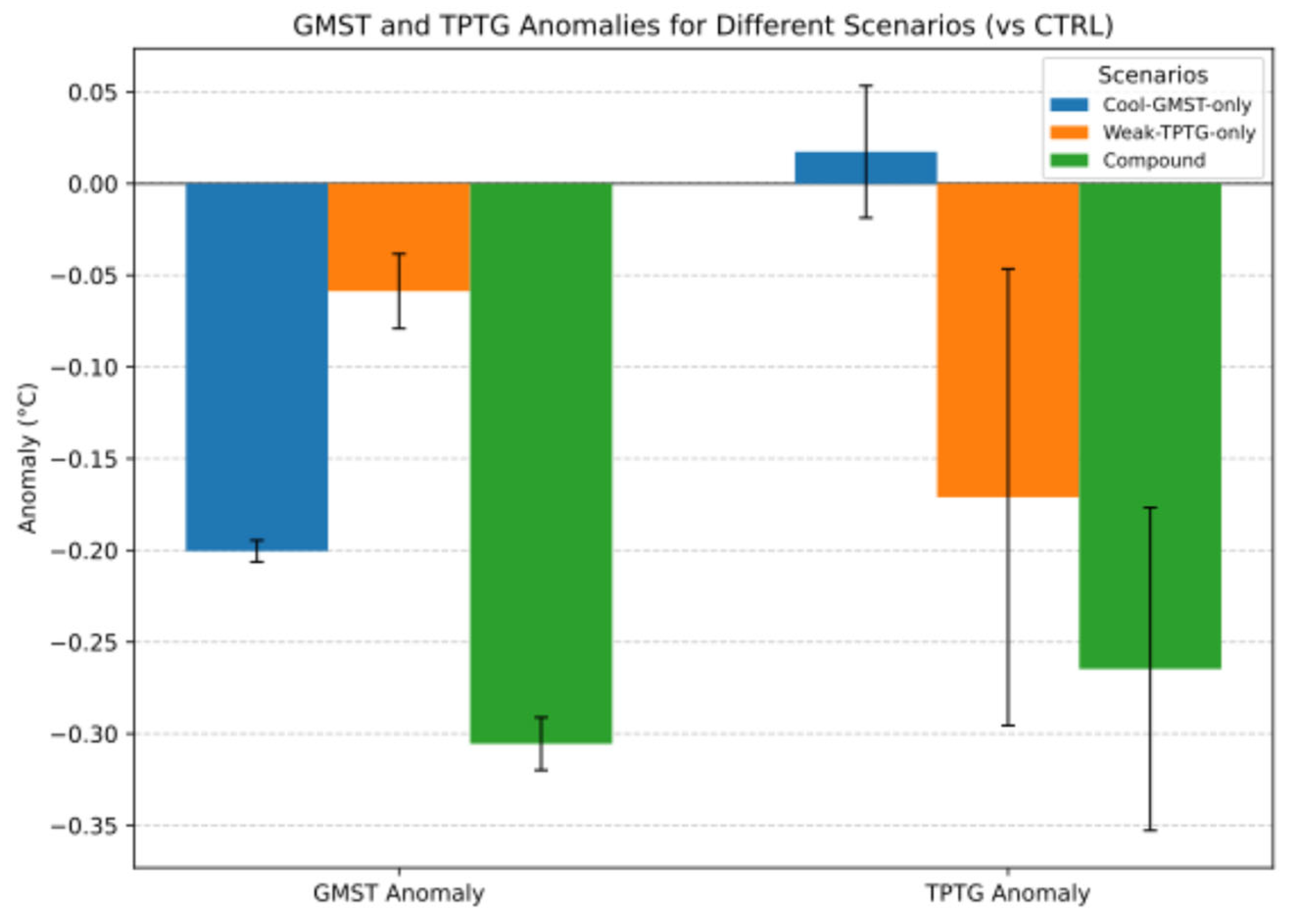
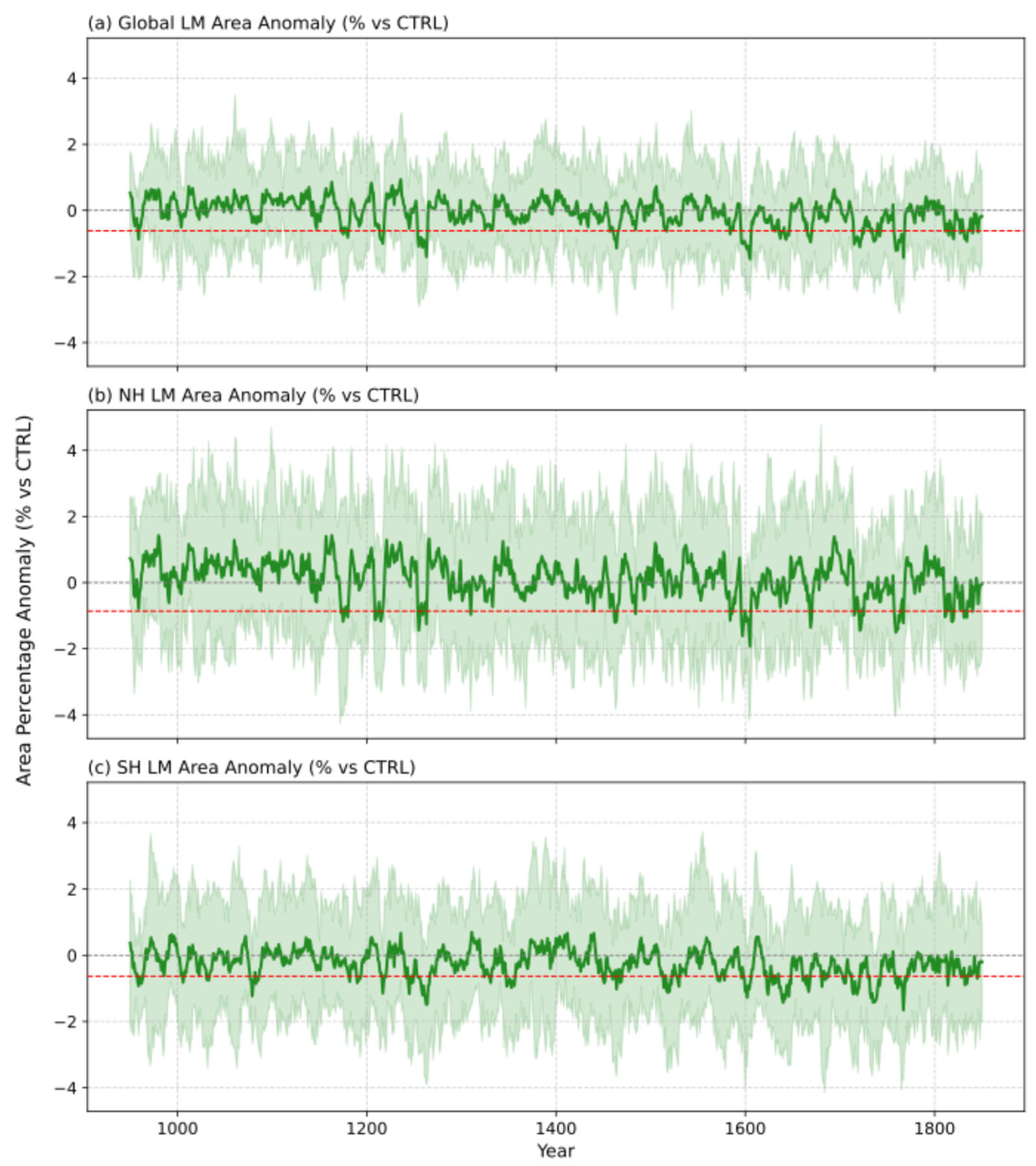
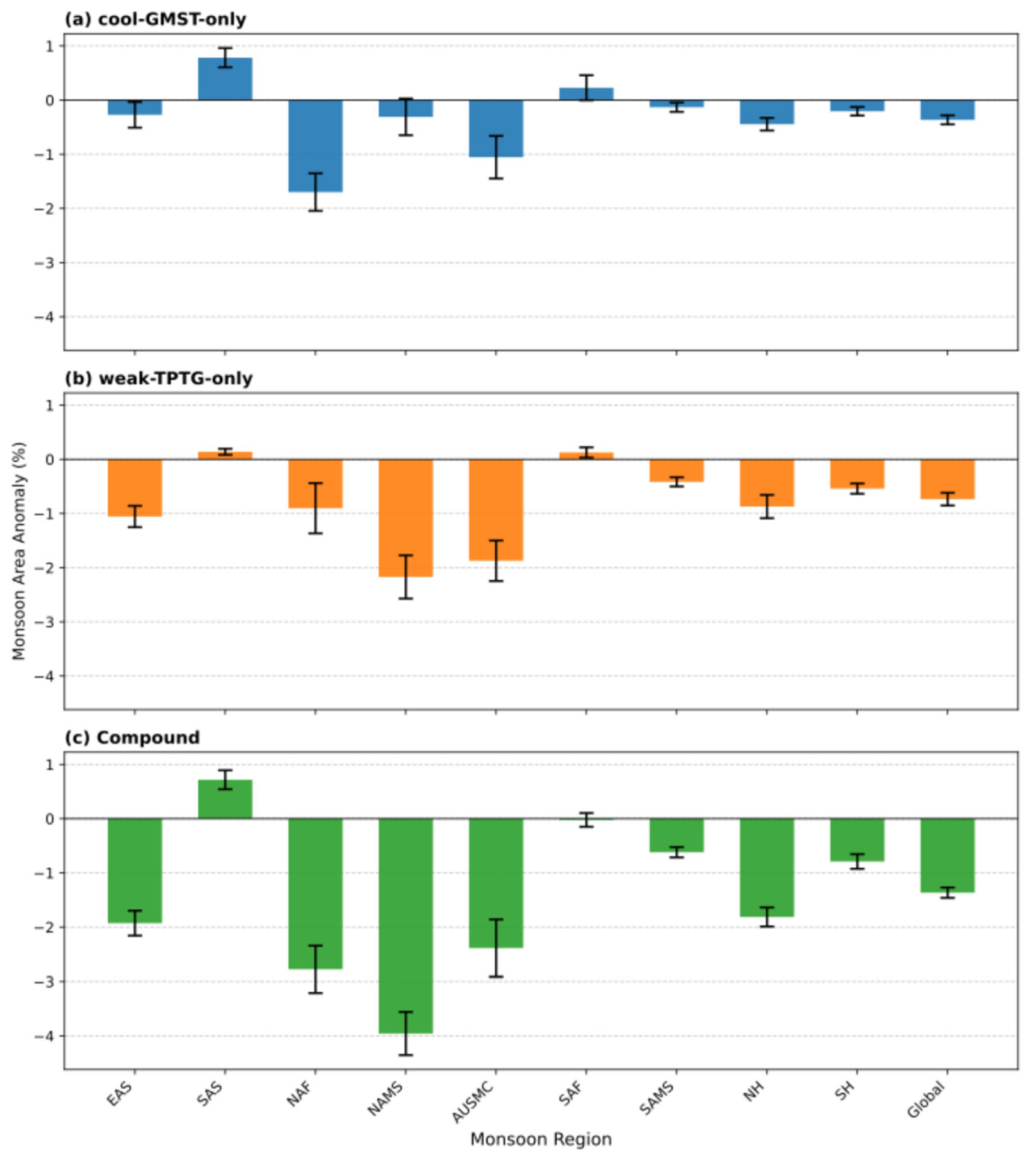
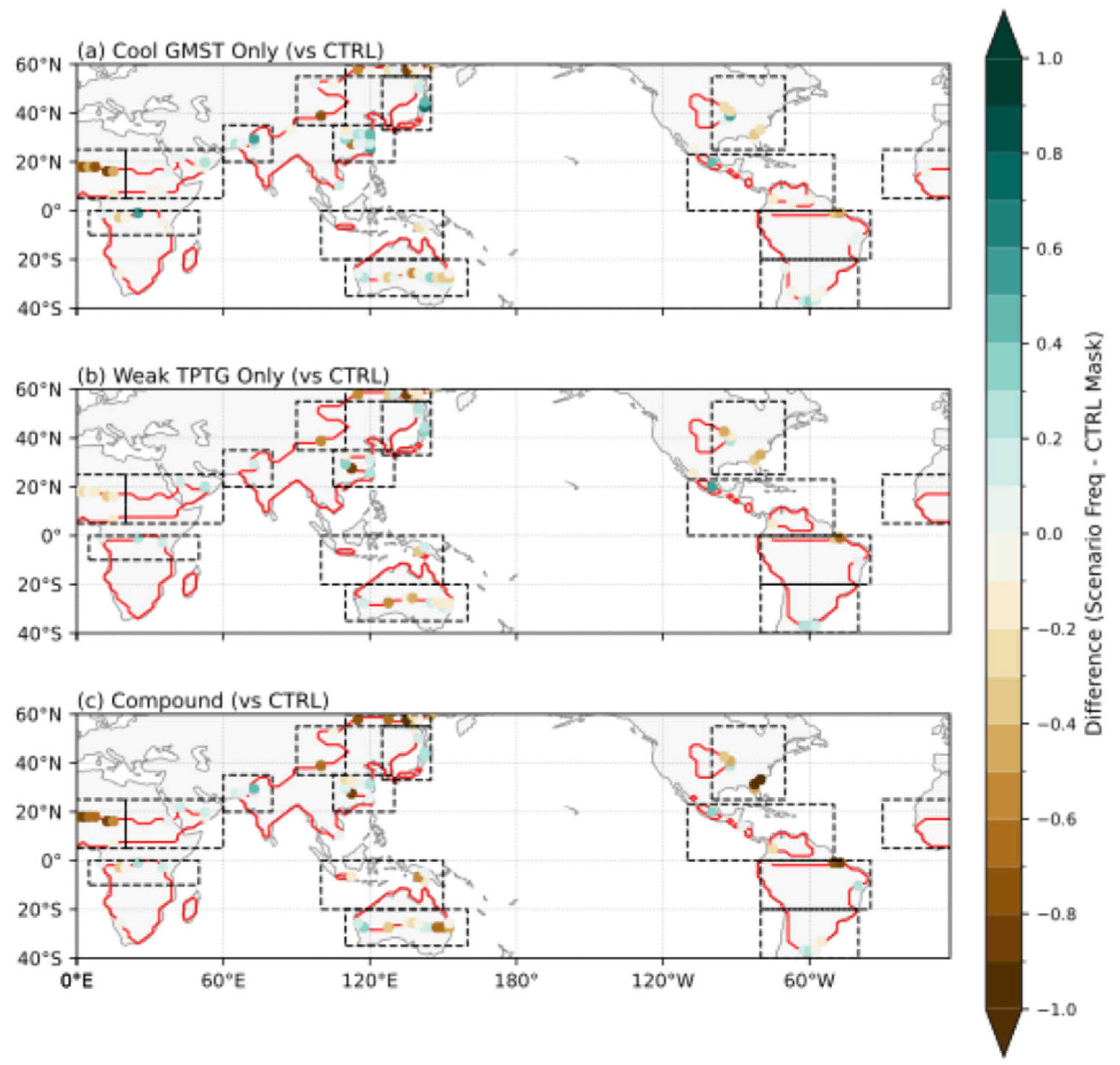
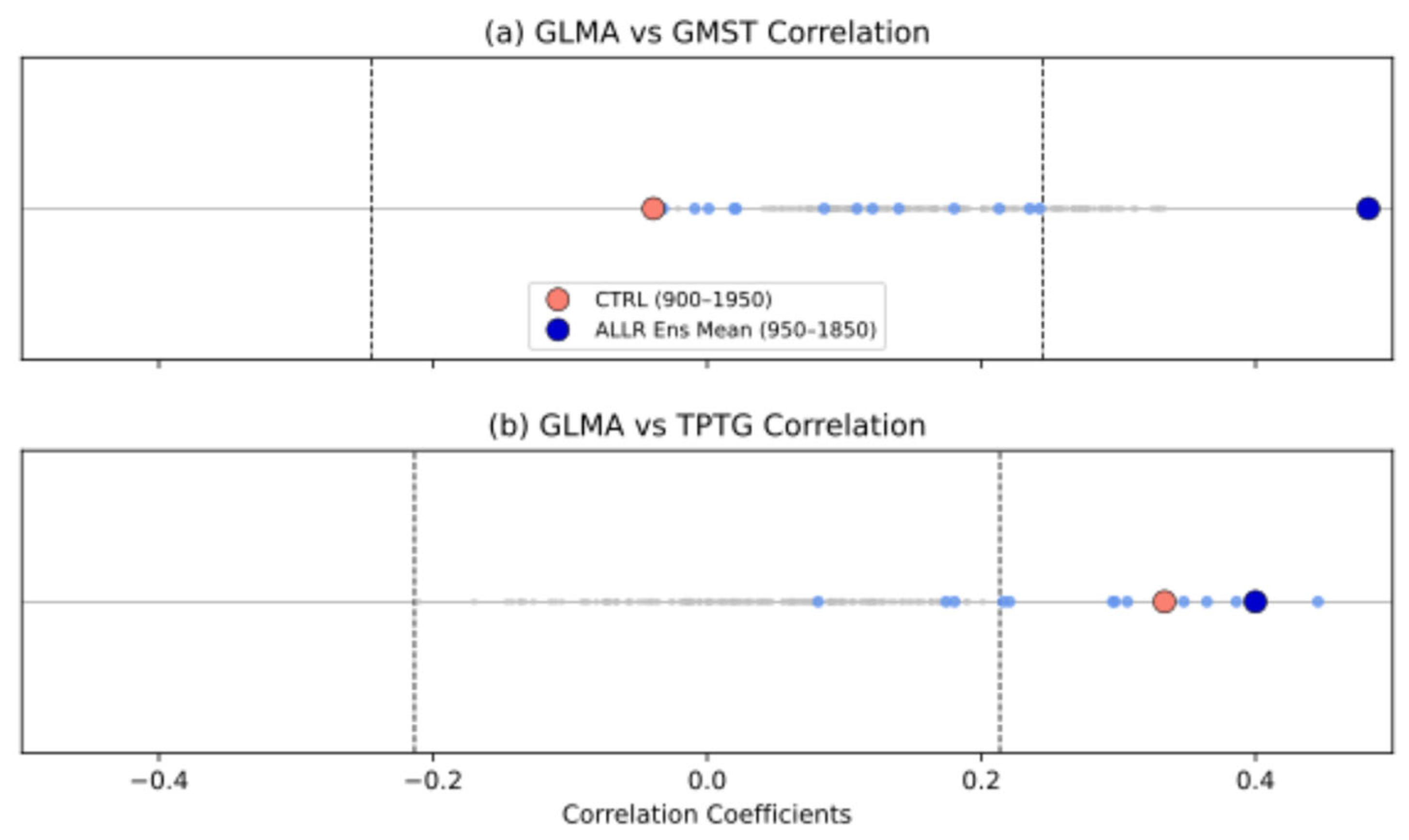

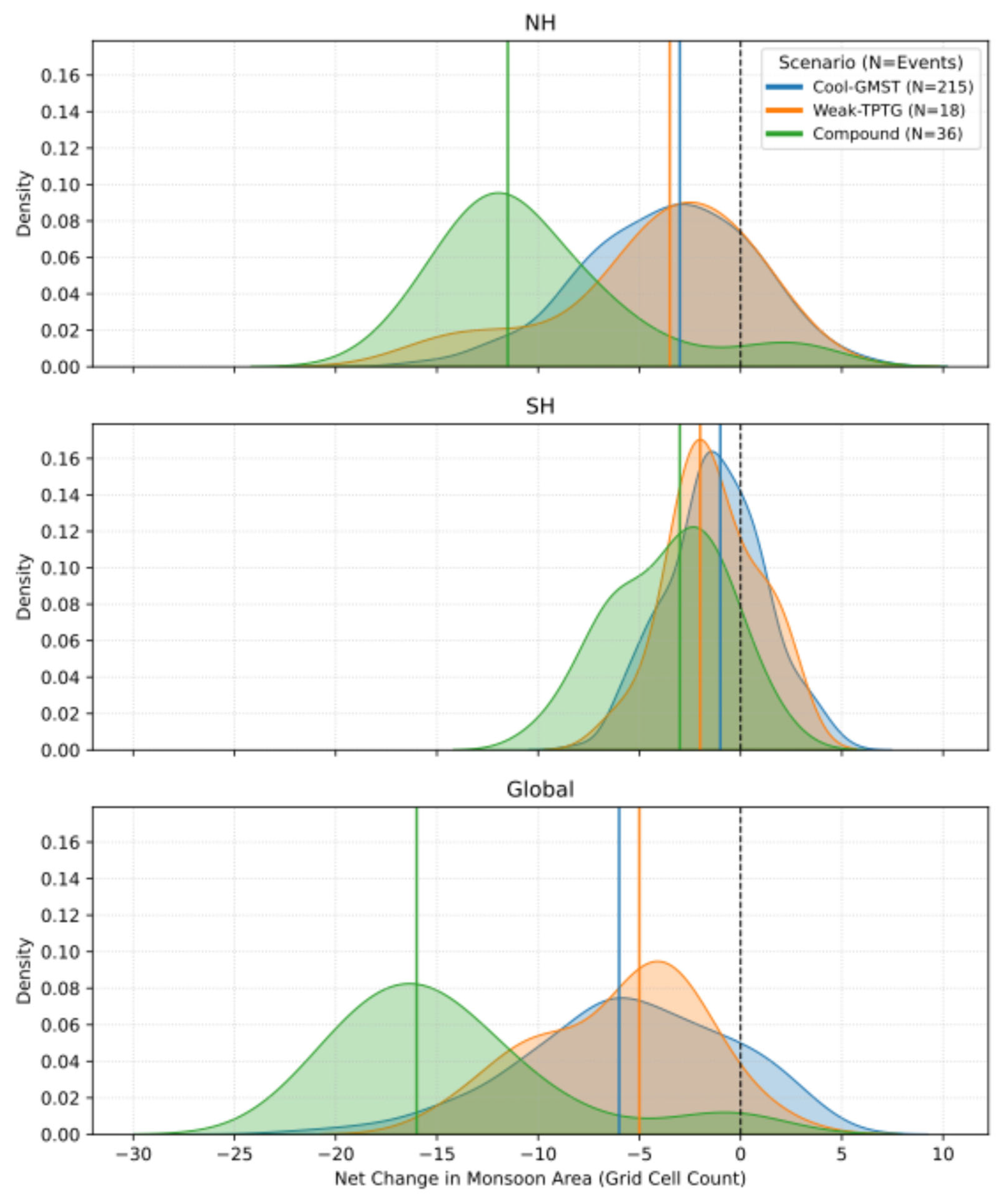
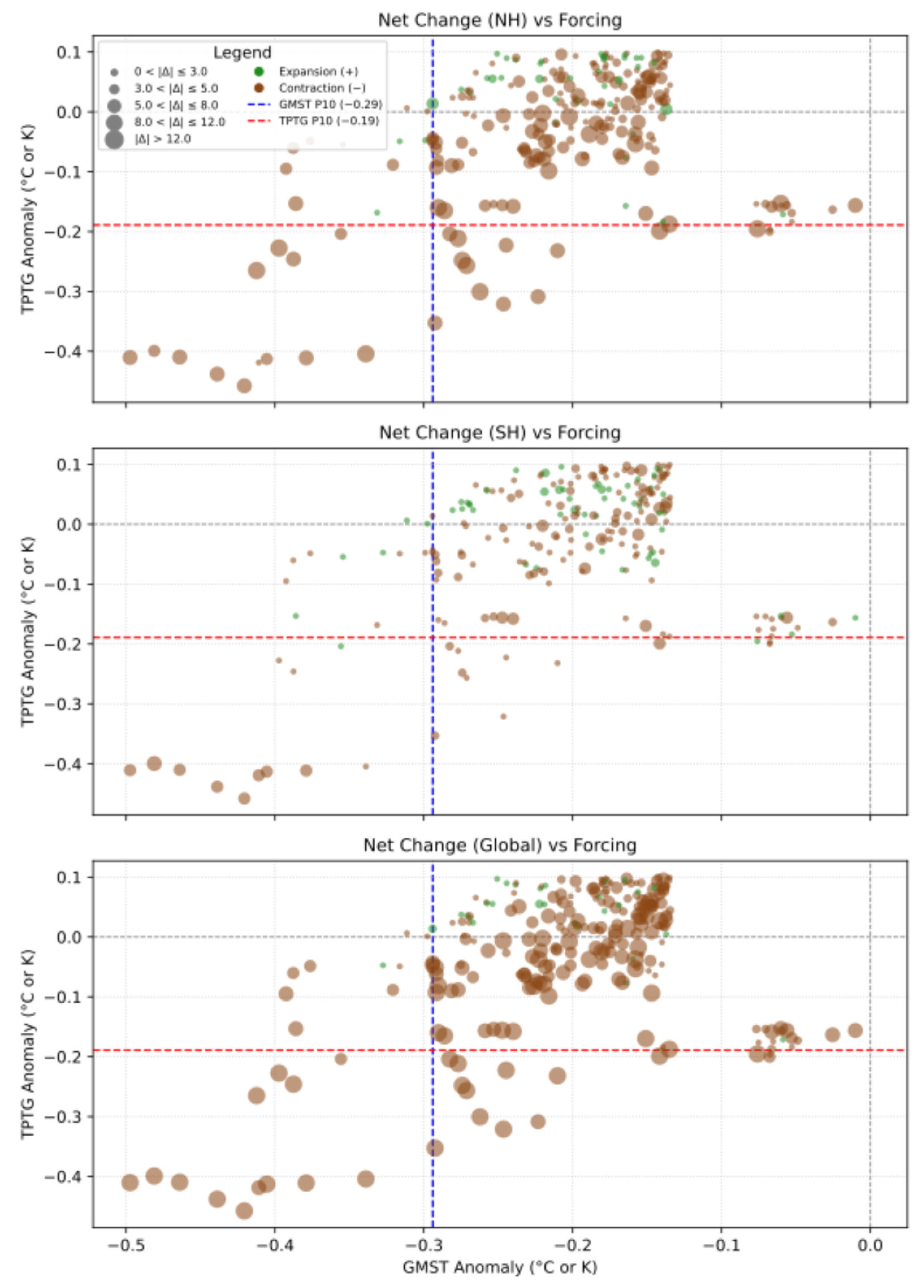
Disclaimer/Publisher’s Note: The statements, opinions and data contained in all publications are solely those of the individual author(s) and contributor(s) and not of MDPI and/or the editor(s). MDPI and/or the editor(s) disclaim responsibility for any injury to people or property resulting from any ideas, methods, instructions or products referred to in the content. |
© 2025 by the authors. Licensee MDPI, Basel, Switzerland. This article is an open access article distributed under the terms and conditions of the Creative Commons Attribution (CC BY) license (https://creativecommons.org/licenses/by/4.0/).
Share and Cite
Gao, S.; Wang, Z.; Jia, J. Global Land Monsoon Area Response to Natural Forcing Drivers over the Last Millennium in a Community Earth System Model Ensemble. Atmosphere 2025, 16, 952. https://doi.org/10.3390/atmos16080952
Gao S, Wang Z, Jia J. Global Land Monsoon Area Response to Natural Forcing Drivers over the Last Millennium in a Community Earth System Model Ensemble. Atmosphere. 2025; 16(8):952. https://doi.org/10.3390/atmos16080952
Chicago/Turabian StyleGao, Sizheng, Zhiyuan Wang, and Jia Jia. 2025. "Global Land Monsoon Area Response to Natural Forcing Drivers over the Last Millennium in a Community Earth System Model Ensemble" Atmosphere 16, no. 8: 952. https://doi.org/10.3390/atmos16080952
APA StyleGao, S., Wang, Z., & Jia, J. (2025). Global Land Monsoon Area Response to Natural Forcing Drivers over the Last Millennium in a Community Earth System Model Ensemble. Atmosphere, 16(8), 952. https://doi.org/10.3390/atmos16080952





